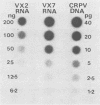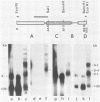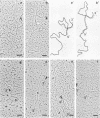Abstract
The physical state and the transcription of the genome of cottontail rabbit papillomavirus (CRPV) in non-virus-producing warts and in the VX2 and VX7 transplantable carcinomas of domestic rabbits were compared. The CRPV DNA present in VX2 and VX7 carcinomas (10 to 20 and 100 to 200 genome equivalents per diploid cell, respectively) was found to be entirely integrated into the cellular DNA, most probably as head-to-tail tandem repeats, in contrast to warts, in which viral DNA (10 to 100 copies per diploid cell) was found only as free, mainly monomeric, molecules. In the VX7 tumor, ca. 50% of the viral DNA molecules were found to be longer than one genome length, indicating that viral DNA rearrangements had occurred. A major viral transcript of 1,250 bases was detected in warts and in VX2 and VX7 carcinomas. Complementary sequences were localized within the E region, the putative transforming region inferred from the nucleotide sequence of the CRPV genome (I. Giri, O. Danos, and M. Yaniv, manuscript in preparation). Analysis of heteroduplexes formed between single-stranded CRPV DNA and polyadenylated RNAs from the VX2 tumor showed that the 1,250-base RNA resulted from the splicing of the sequences corresponding to the open reading frame E6 to those corresponding to the 3' third of E2. A second viral transcript, measuring 2,000 bases, was detected in warts and, in lesser amounts than the 1,250-base species, in VX2 carcinoma, and a 2,100-base RNA was found in VX7 carcinoma. Complementary sequences to these messengers were localized to the same part of the genome as the 1,250-base species and to a contiguous fragment situated upstream. Heteroduplex analysis showed that the 2,000-base species from VX2 carcinoma resulted from the splicing of the sequences corresponding to E6 and E7 to those corresponding to the 3' third of E2. The sequences spliced out upon the maturation of the two messengers of VX2 carcinoma correspond to E1, the two-thirds of E2, and most of E4. Additional transcripts were found in VX7 carcinoma, a major 3,100-base species transcribed from the E region, and several minor species, measuring from 2,400 bases, which all hybridize with a subgenomic fragment contained in the L region encoding the viral capsid polypeptides. This could account for the antiviral antibodies found in animals bearing the VX7 carcinoma.
Full text
PDF
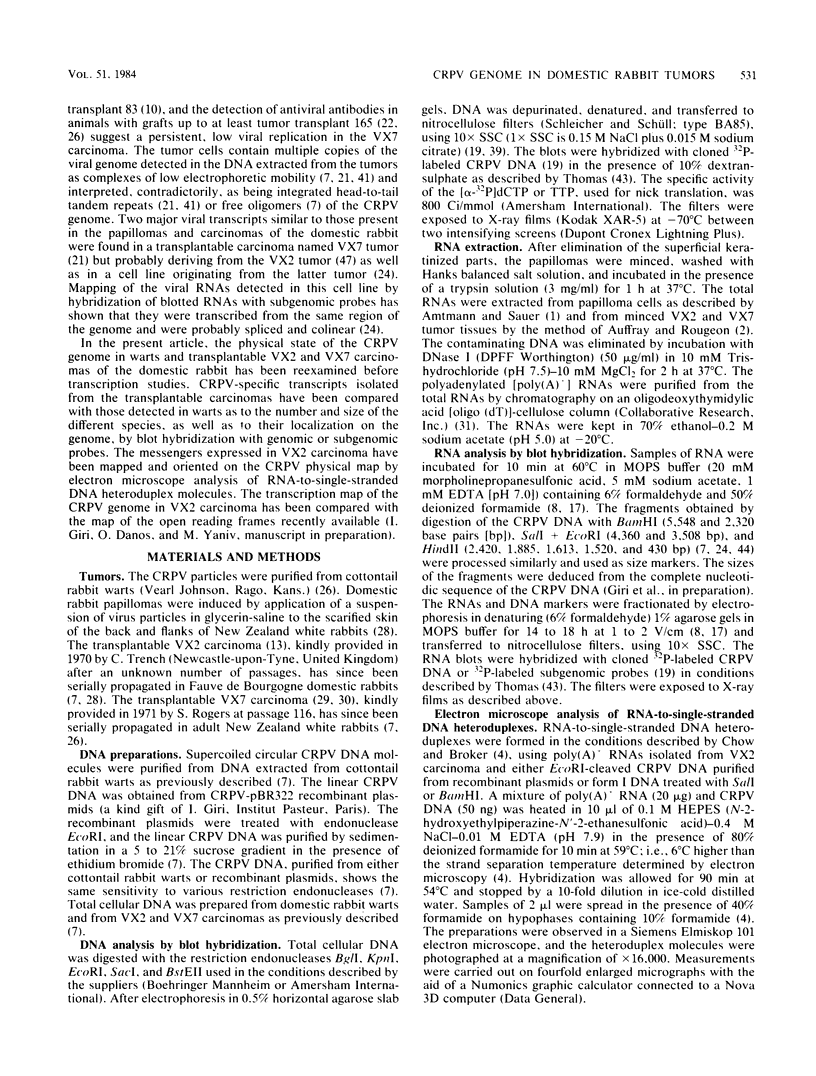
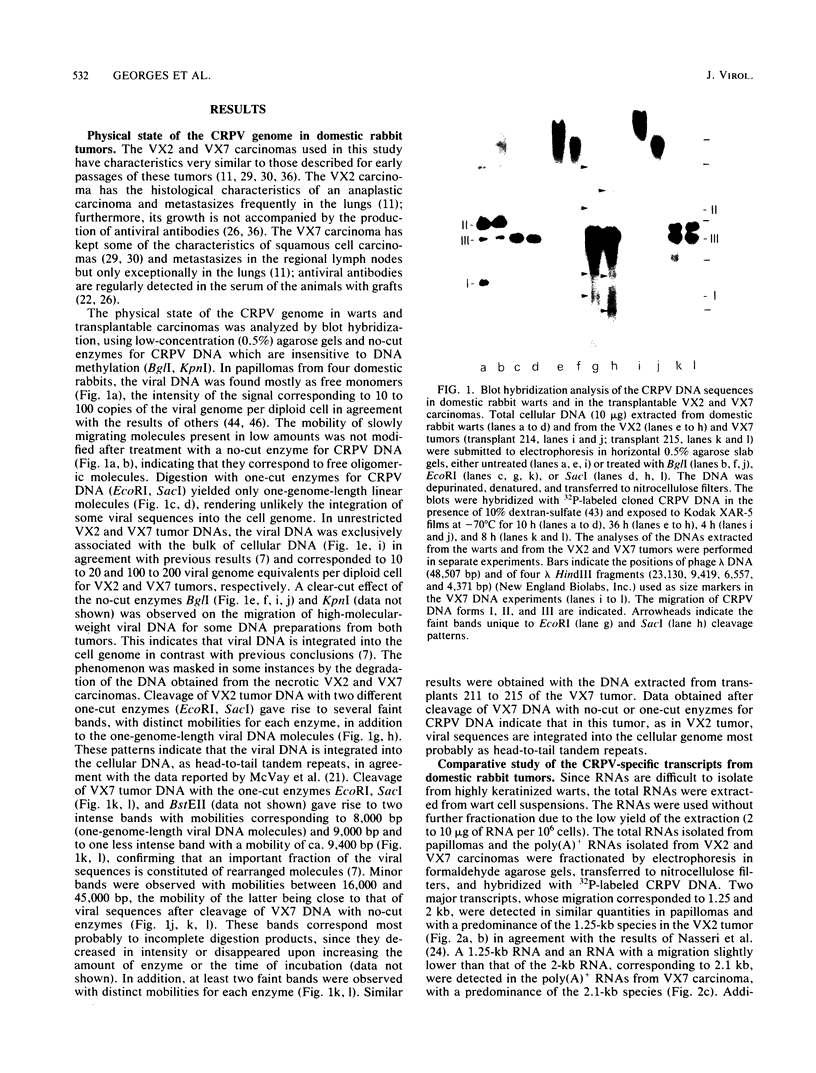
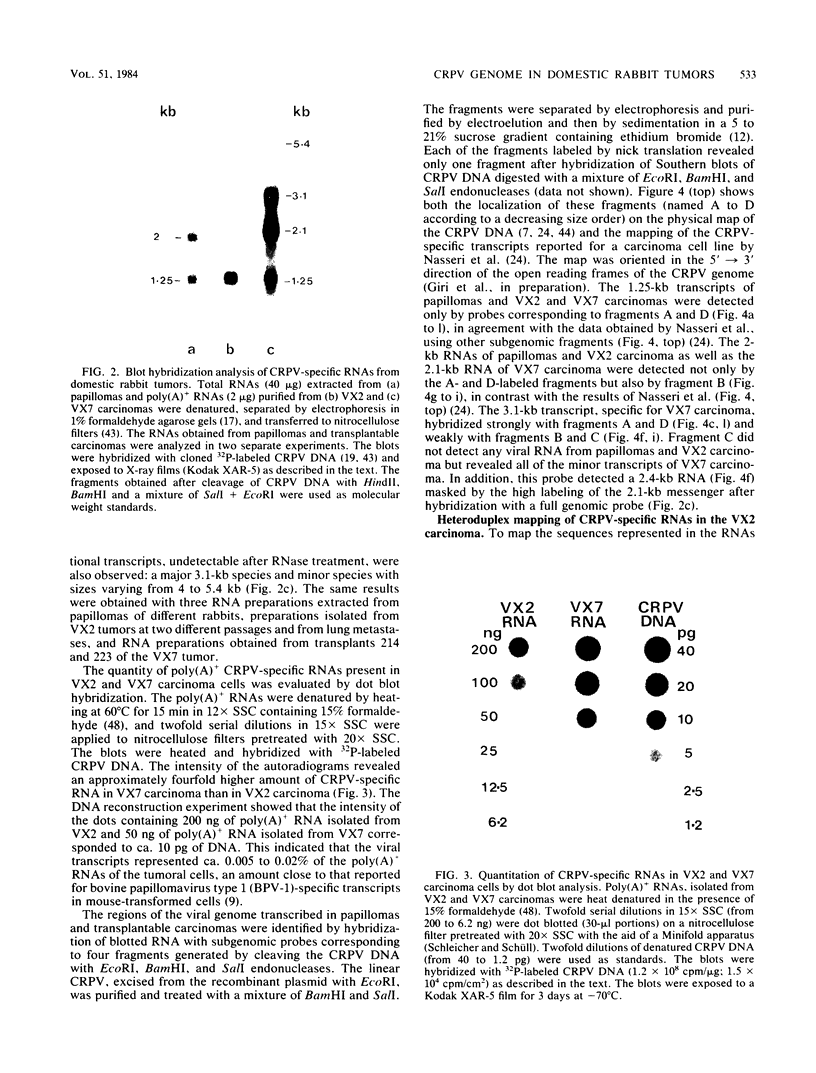
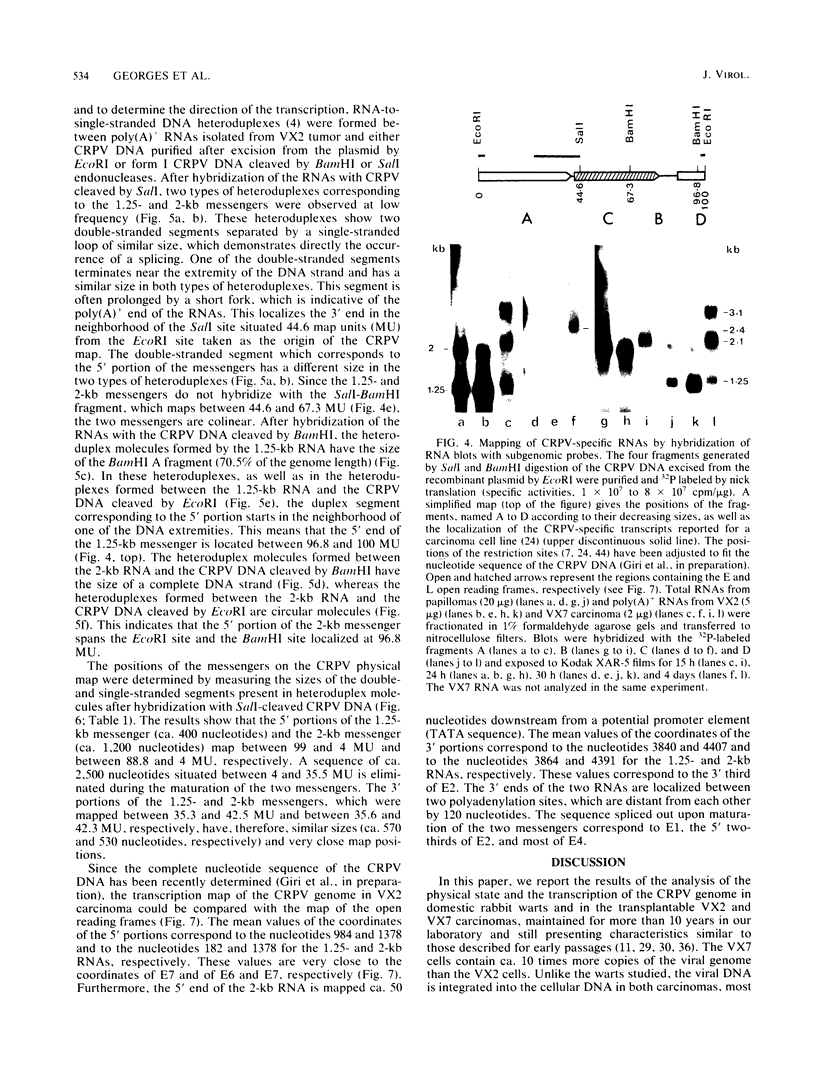
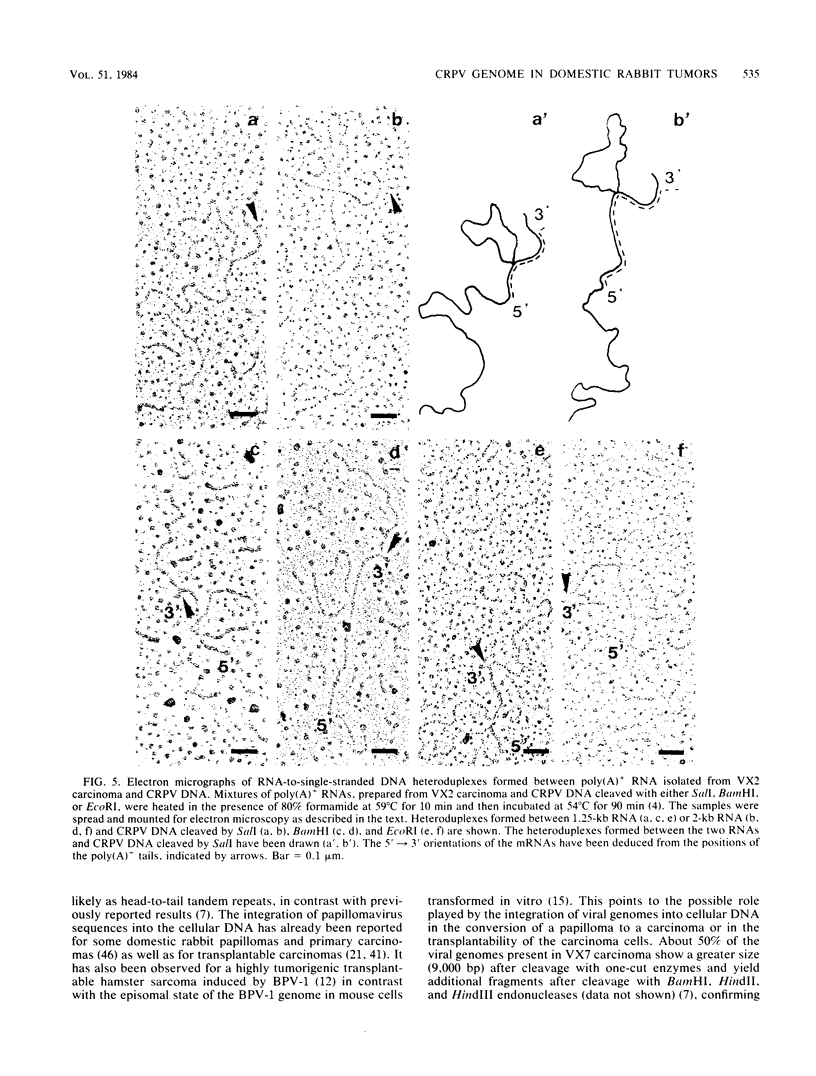
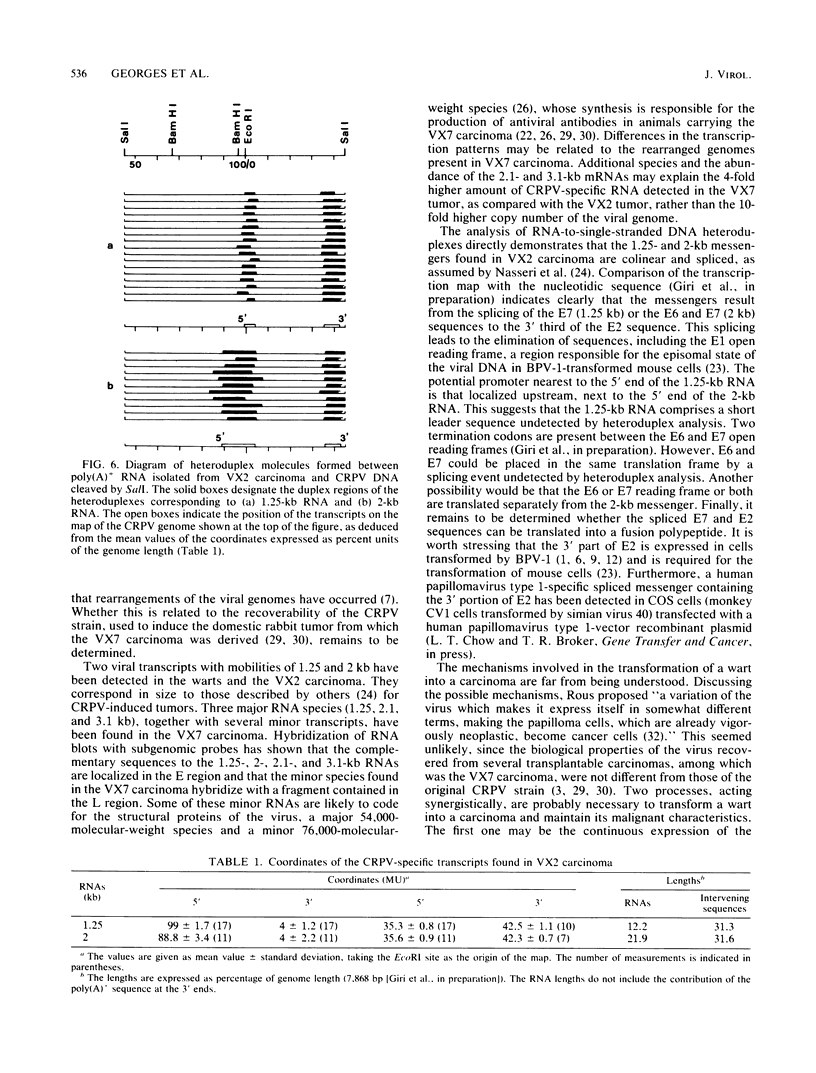
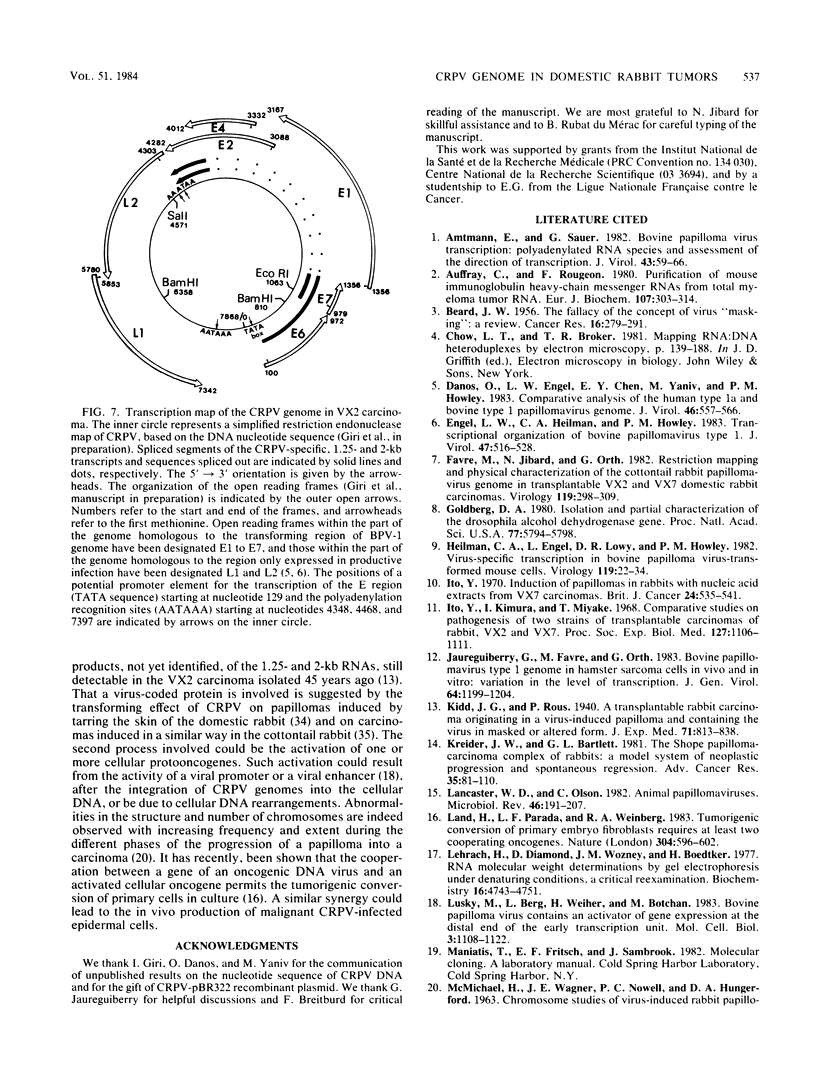
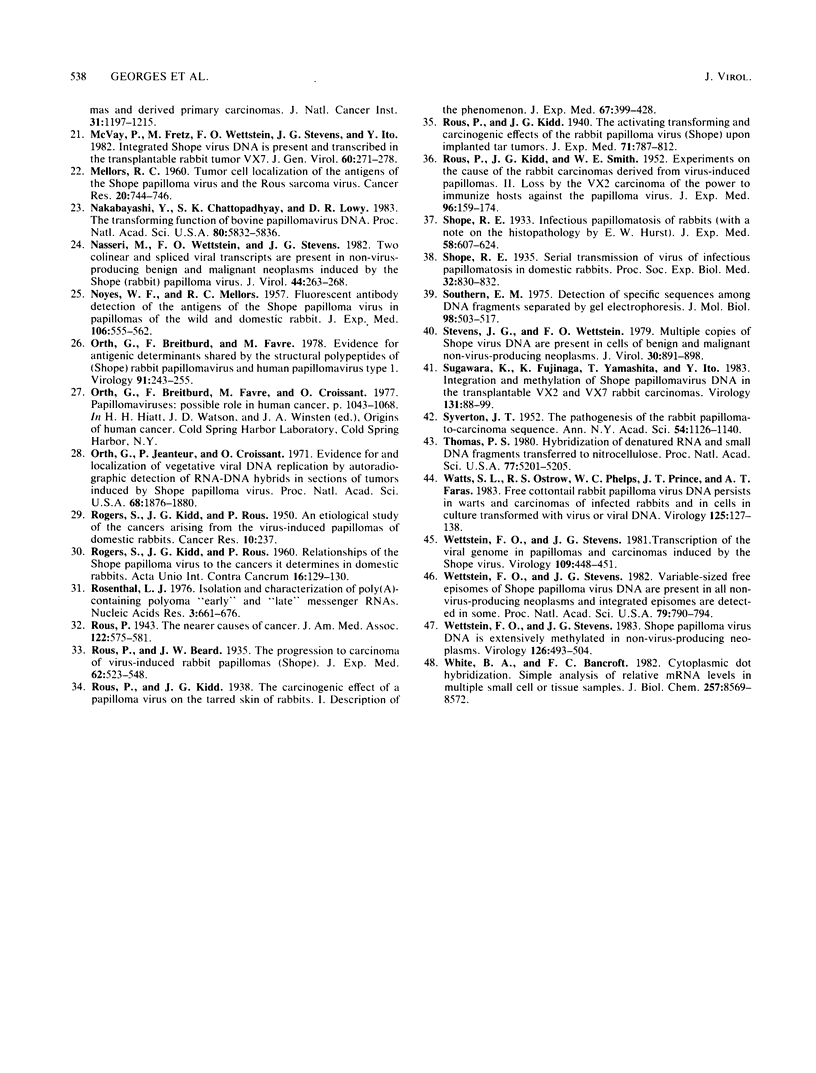
Images in this article
Selected References
These references are in PubMed. This may not be the complete list of references from this article.
- Amtmann E., Sauer G. Bovine papilloma virus transcription: polyadenylated RNA species and assessment of the direction of transcription. J Virol. 1982 Jul;43(1):59–66. doi: 10.1128/jvi.43.1.59-66.1982. [DOI] [PMC free article] [PubMed] [Google Scholar]
- Auffray C., Rougeon F. Purification of mouse immunoglobulin heavy-chain messenger RNAs from total myeloma tumor RNA. Eur J Biochem. 1980 Jun;107(2):303–314. doi: 10.1111/j.1432-1033.1980.tb06030.x. [DOI] [PubMed] [Google Scholar]
- BEARD J. W. The fallacy of the concept of virus masking: a review. Cancer Res. 1956 May;16(4):279–291. [PubMed] [Google Scholar]
- Danos O., Engel L. W., Chen E. Y., Yaniv M., Howley P. M. Comparative analysis of the human type 1a and bovine type 1 papillomavirus genomes. J Virol. 1983 May;46(2):557–566. doi: 10.1128/jvi.46.2.557-566.1983. [DOI] [PMC free article] [PubMed] [Google Scholar]
- Engel L. W., Heilman C. A., Howley P. M. Transcriptional organization of bovine papillomavirus type 1. J Virol. 1983 Sep;47(3):516–528. doi: 10.1128/jvi.47.3.516-528.1983. [DOI] [PMC free article] [PubMed] [Google Scholar]
- Favre M., Jibard N., Orth G. Restriction mapping and physical characterization of the cottontail rabbit papillomavirus genome in transplantable VX2 and VX7 domestic rabbit carcinomas. Virology. 1982 Jun;119(2):298–309. doi: 10.1016/0042-6822(82)90090-3. [DOI] [PubMed] [Google Scholar]
- Goldberg D. A. Isolation and partial characterization of the Drosophila alcohol dehydrogenase gene. Proc Natl Acad Sci U S A. 1980 Oct;77(10):5794–5798. doi: 10.1073/pnas.77.10.5794. [DOI] [PMC free article] [PubMed] [Google Scholar]
- Heilman C. A., Engel L., Lowy D. R., Howley P. M. Virus-specific transcription in bovine papillomavirus-transformed mouse cells. Virology. 1982 May;119(1):22–34. doi: 10.1016/0042-6822(82)90061-7. [DOI] [PubMed] [Google Scholar]
- Ito Y. Induction of papillomas in rabbits with nucleic acid extracts from Vx7 carcinomas. Br J Cancer. 1970 Sep;24(3):535–541. doi: 10.1038/bjc.1970.64. [DOI] [PMC free article] [PubMed] [Google Scholar]
- Jaureguiberry G., Favre M., Orth G. Bovine papillomavirus type 1 genome in hamster sarcoma cells in vivo and in vitro: variation in the level of transcription. J Gen Virol. 1983 May;64(Pt 5):1199–1204. doi: 10.1099/0022-1317-64-5-1199. [DOI] [PubMed] [Google Scholar]
- Kreider J. W., Bartlett G. L. The Shope papilloma-carcinoma complex of rabbits: a model system of neoplastic progression and spontaneous regression. Adv Cancer Res. 1981;35:81–110. doi: 10.1016/s0065-230x(08)60909-4. [DOI] [PubMed] [Google Scholar]
- Lancaster W. D., Olson C. Animal papillomaviruses. Microbiol Rev. 1982 Jun;46(2):191–207. doi: 10.1128/mr.46.2.191-207.1982. [DOI] [PMC free article] [PubMed] [Google Scholar]
- Land H., Parada L. F., Weinberg R. A. Tumorigenic conversion of primary embryo fibroblasts requires at least two cooperating oncogenes. Nature. 1983 Aug 18;304(5927):596–602. doi: 10.1038/304596a0. [DOI] [PubMed] [Google Scholar]
- Lehrach H., Diamond D., Wozney J. M., Boedtker H. RNA molecular weight determinations by gel electrophoresis under denaturing conditions, a critical reexamination. Biochemistry. 1977 Oct 18;16(21):4743–4751. doi: 10.1021/bi00640a033. [DOI] [PubMed] [Google Scholar]
- Lusky M., Berg L., Weiher H., Botchan M. Bovine papilloma virus contains an activator of gene expression at the distal end of the early transcription unit. Mol Cell Biol. 1983 Jun;3(6):1108–1122. doi: 10.1128/mcb.3.6.1108. [DOI] [PMC free article] [PubMed] [Google Scholar]
- McVay P., Fretz M., Wettstein F., Stevens J., Ito Y. Integrated shope virus DNA is present and transcribed in the transplantable rabbit tumour Vx-7. J Gen Virol. 1982 Jun;60(Pt 2):271–278. doi: 10.1099/0022-1317-60-2-271. [DOI] [PubMed] [Google Scholar]
- NOYES W. F., MELLORS R. C. Fluorescent antibody detection of the antigens of the Shope papilloma virus in papillomas of the wild and domestic rabbit. J Exp Med. 1957 Oct 1;106(4):555–562. doi: 10.1084/jem.106.4.555. [DOI] [PMC free article] [PubMed] [Google Scholar]
- Nakabayashi Y., Chattopadhyay S. K., Lowy D. R. The transforming function of bovine papillomavirus DNA. Proc Natl Acad Sci U S A. 1983 Oct;80(19):5832–5836. doi: 10.1073/pnas.80.19.5832. [DOI] [PMC free article] [PubMed] [Google Scholar]
- Nasseri M., Wettstein F. O., Stevens J. G. Two colinear and spliced viral transcripts are present in non-virus-producing benign and malignant neoplasms induced by the shope (rabbit) papilloma virus. J Virol. 1982 Oct;44(1):263–268. doi: 10.1128/jvi.44.1.263-268.1982. [DOI] [PMC free article] [PubMed] [Google Scholar]
- Orth G., Breitburd F., Favre M. Evidence for antigenic determinants shared by the structural polypeptides of (Shope) rabbit papillomavirus and human papillomavirus type 1. Virology. 1978 Dec;91(2):243–255. doi: 10.1016/0042-6822(78)90373-2. [DOI] [PubMed] [Google Scholar]
- Orth G., Jeanteur P., Croissant O. Evidence for and localization of vegetative viral DNA replication by autoradiographic detection of RNA-DNA hybrids in sections of tumors induced by Shope papilloma virus. Proc Natl Acad Sci U S A. 1971 Aug;68(8):1876–1880. doi: 10.1073/pnas.68.8.1876. [DOI] [PMC free article] [PubMed] [Google Scholar]
- ROGERS S., KIDD J. G., ROUS P. Relationships of the Shope papilloma virus to the cancers it determines in domestic rabbits. Acta Unio Int Contra Cancrum. 1960;16:129–130. [PubMed] [Google Scholar]
- ROUS P., KIDD J. G., SMITH W. E. Experiments on the cause of the rabbit carcinomas derived from virus-induced papillomas. II. Loss by the Vx2 carcinoma of the power to immunize hosts against the papilloma virus. J Exp Med. 1952 Aug;96(2):159–174. doi: 10.1084/jem.96.2.159. [DOI] [PMC free article] [PubMed] [Google Scholar]
- Rosenthal L. J. Isolation and characterization of poly(A)-containing polyoma "early" and "late" messenger RNAs. Nucleic Acids Res. 1976 Mar;3(3):661–676. doi: 10.1093/nar/3.3.661. [DOI] [PMC free article] [PubMed] [Google Scholar]
- SYVERTON J. T. The pathogenesis of the rabbit papilloma-to-carcinoma sequence. Ann N Y Acad Sci. 1952 Jul 10;54(6):1126–1140. doi: 10.1111/j.1749-6632.1952.tb39983.x. [DOI] [PubMed] [Google Scholar]
- Southern E. M. Detection of specific sequences among DNA fragments separated by gel electrophoresis. J Mol Biol. 1975 Nov 5;98(3):503–517. doi: 10.1016/s0022-2836(75)80083-0. [DOI] [PubMed] [Google Scholar]
- Stevens J. G., Wettstein F. O. Multiple copies of Shope virus DNA are present in cells of benign and malignant non-virus-producing neoplasms. J Virol. 1979 Jun;30(3):891–898. doi: 10.1128/jvi.30.3.891-898.1979. [DOI] [PMC free article] [PubMed] [Google Scholar]
- Sugawara K., Fujinaga K., Yamashita T., Ito Y. Integration and methylation of shope papilloma virus DNA in the transplantable Vx2 and Vx7 rabbit carcinomas. Virology. 1983 Nov;131(1):88–99. doi: 10.1016/0042-6822(83)90536-6. [DOI] [PubMed] [Google Scholar]
- Thomas P. S. Hybridization of denatured RNA and small DNA fragments transferred to nitrocellulose. Proc Natl Acad Sci U S A. 1980 Sep;77(9):5201–5205. doi: 10.1073/pnas.77.9.5201. [DOI] [PMC free article] [PubMed] [Google Scholar]
- Watts S. L., Ostrow R. S., Phelps W. C., Prince J. T., Faras A. J. Free cottontail rabbit papillomavirus DNA persists in warts and carcinomas of infected rabbits and in cells in culture transformed with virus or viral DNA. Virology. 1983 Feb;125(1):127–138. doi: 10.1016/0042-6822(83)90069-7. [DOI] [PubMed] [Google Scholar]
- Wettstein F. O., Stevens J. G. Shope papilloma virus DNA is extensively methylated in non-virus-producing neoplasms. Virology. 1983 Apr 30;126(2):493–504. doi: 10.1016/s0042-6822(83)80007-5. [DOI] [PubMed] [Google Scholar]
- Wettstein F. O., Stevens J. G. Transcription of the viral genome in papillomas and carcinomas induced by the Shope virus. Virology. 1981 Mar;109(2):448–451. doi: 10.1016/0042-6822(81)90517-1. [DOI] [PubMed] [Google Scholar]
- Wettstein F. O., Stevens J. G. Variable-sized free episomes of Shope papilloma virus DNA are present in all non-virus-producing neoplasms and integrated episomes are detected in some. Proc Natl Acad Sci U S A. 1982 Feb;79(3):790–794. doi: 10.1073/pnas.79.3.790. [DOI] [PMC free article] [PubMed] [Google Scholar]
- White B. A., Bancroft F. C. Cytoplasmic dot hybridization. Simple analysis of relative mRNA levels in multiple small cell or tissue samples. J Biol Chem. 1982 Aug 10;257(15):8569–8572. [PubMed] [Google Scholar]





